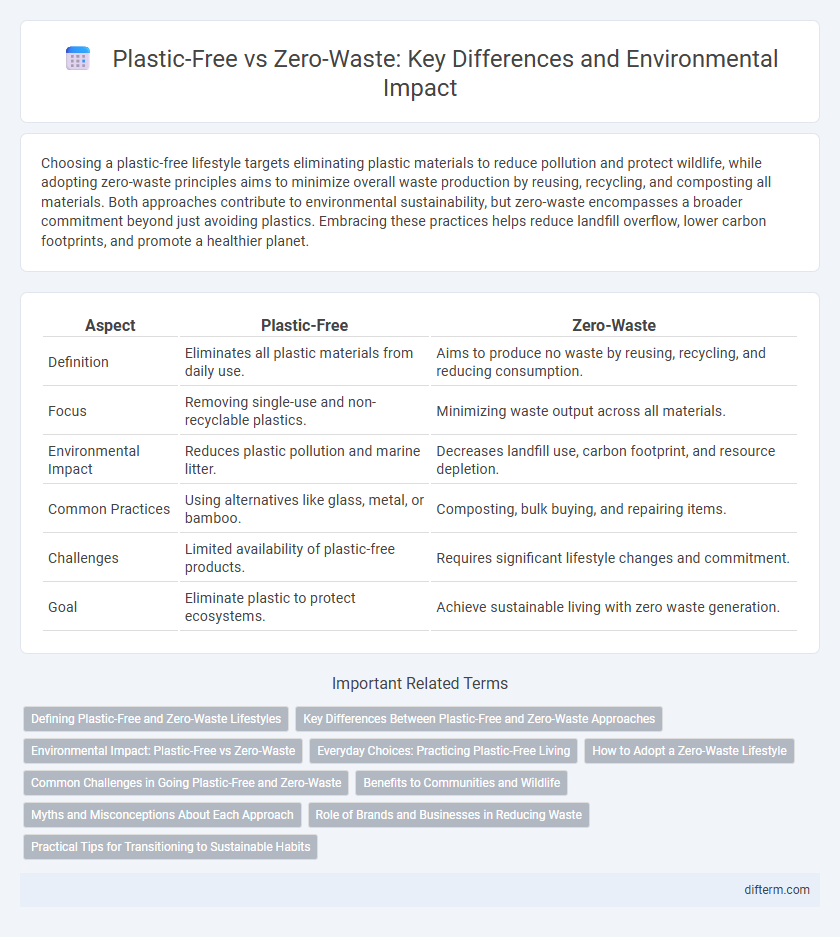Choosing a plastic-free lifestyle targets eliminating plastic materials to reduce pollution and protect wildlife, while adopting zero-waste principles aims to minimize overall waste production by reusing, recycling, and composting all materials. Both approaches contribute to environmental sustainability, but zero-waste encompasses a broader commitment beyond just avoiding plastics. Embracing these practices helps reduce landfill overflow, lower carbon footprints, and promote a healthier planet.
Table of Comparison
| Aspect | Plastic-Free | Zero-Waste |
|---|---|---|
| Definition | Eliminates all plastic materials from daily use. | Aims to produce no waste by reusing, recycling, and reducing consumption. |
| Focus | Removing single-use and non-recyclable plastics. | Minimizing waste output across all materials. |
| Environmental Impact | Reduces plastic pollution and marine litter. | Decreases landfill use, carbon footprint, and resource depletion. |
| Common Practices | Using alternatives like glass, metal, or bamboo. | Composting, bulk buying, and repairing items. |
| Challenges | Limited availability of plastic-free products. | Requires significant lifestyle changes and commitment. |
| Goal | Eliminate plastic to protect ecosystems. | Achieve sustainable living with zero waste generation. |
Defining Plastic-Free and Zero-Waste Lifestyles
Plastic-free lifestyles emphasize eliminating single-use plastics and substituting them with sustainable alternatives like glass or metal to reduce environmental pollution. Zero-waste lifestyles aim to minimize overall waste production by encouraging reuse, recycling, and composting, promoting a circular economy approach. Both approaches contribute significantly to reducing landfill waste and conserving natural resources but differ in scope and daily practice focus.
Key Differences Between Plastic-Free and Zero-Waste Approaches
Plastic-free approaches specifically target the elimination of plastic materials to reduce pollution and environmental harm, focusing on alternatives like glass, metal, or biodegradable items. Zero-waste strategies encompass a broader goal of minimizing all types of waste by promoting practices such as recycling, composting, and reusing materials across various consumption categories. Key differences lie in scope and methodology: plastic-free zeroes in on eliminating plastic alone, while zero-waste aims for comprehensive waste reduction through systemic lifestyle changes.
Environmental Impact: Plastic-Free vs Zero-Waste
Plastic-free initiatives primarily reduce reliance on plastic materials, mitigating ocean pollution and microplastic contamination. Zero-waste practices emphasize minimizing overall waste generation through reuse, recycling, and composting, significantly lowering landfill contributions and resource extraction. Both approaches collectively enhance environmental health but zero-waste strategies offer broader impact by targeting multiple waste streams beyond plastic.
Everyday Choices: Practicing Plastic-Free Living
Choosing plastic-free products significantly reduces microplastic pollution and lowers reliance on fossil fuel-based materials, offering a tangible environmental benefit in everyday life. Reusable alternatives like glass, stainless steel, and natural fibers prevent single-use plastic waste accumulation in oceans and landfills. Mindful purchasing decisions reduce carbon footprints and support sustainable manufacturing practices essential for a zero-waste lifestyle.
How to Adopt a Zero-Waste Lifestyle
Adopting a zero-waste lifestyle involves minimizing waste by refusing, reducing, reusing, recycling, and composting to significantly lower your environmental impact. Prioritize purchasing products with minimal packaging, carry reusable bags, containers, and utensils, and support bulk stores to avoid single-use plastics. Emphasizing waste reduction through conscious consumption and responsible disposal promotes sustainability beyond just eliminating plastic, addressing overall resource conservation.
Common Challenges in Going Plastic-Free and Zero-Waste
Common challenges in going plastic-free and zero-waste include limited availability of sustainable alternatives and high upfront costs of eco-friendly products. Consumers often face difficulties in identifying truly plastic-free packaging due to greenwashing and confusing labels. Maintaining consistent habits requires overcoming social norms and convenience barriers, which can hinder long-term commitment to sustainable living.
Benefits to Communities and Wildlife
Plastic-free initiatives reduce pollution in oceans and land, directly benefiting marine life and terrestrial wildlife by minimizing ingestion and entanglement risks. Zero-waste practices promote resource conservation and reduce landfill reliance, creating healthier ecosystems and improving community health through decreased exposure to toxic waste. Both approaches foster sustainable living, enhancing biodiversity and supporting resilient, eco-conscious communities.
Myths and Misconceptions About Each Approach
Plastic-free lifestyles are often misunderstood as completely eliminating all plastics, but they primarily focus on reducing single-use plastics rather than all plastic products. Zero-waste practices are commonly mistaken for producing no trash whatsoever, whereas the goal is to minimize waste by prioritizing reuse, composting, and recycling. Both approaches emphasize sustainability but differ in scope and practicality, with key misconceptions hindering broader adoption.
Role of Brands and Businesses in Reducing Waste
Brands and businesses play a crucial role in reducing waste by adopting plastic-free packaging and promoting zero-waste production processes. Implementing sustainable material sourcing, designing reusable or compostable products, and encouraging circular economy models significantly decrease plastic pollution and landfill accumulation. Corporate commitment to transparency and consumer education drives broader environmental responsibility and accelerates the transition to sustainable consumption patterns.
Practical Tips for Transitioning to Sustainable Habits
Choosing plastic-free alternatives like reusable bags, glass containers, and metal straws significantly reduces single-use plastic waste in daily life. Embracing zero-waste principles involves mindful consumption, composting organic waste, and repairing or repurposing items to minimize landfill contributions. Combining these strategies fosters sustainable habits that protect ecosystems and promote long-term environmental health.
plastic-free vs zero-waste Infographic

 difterm.com
difterm.com